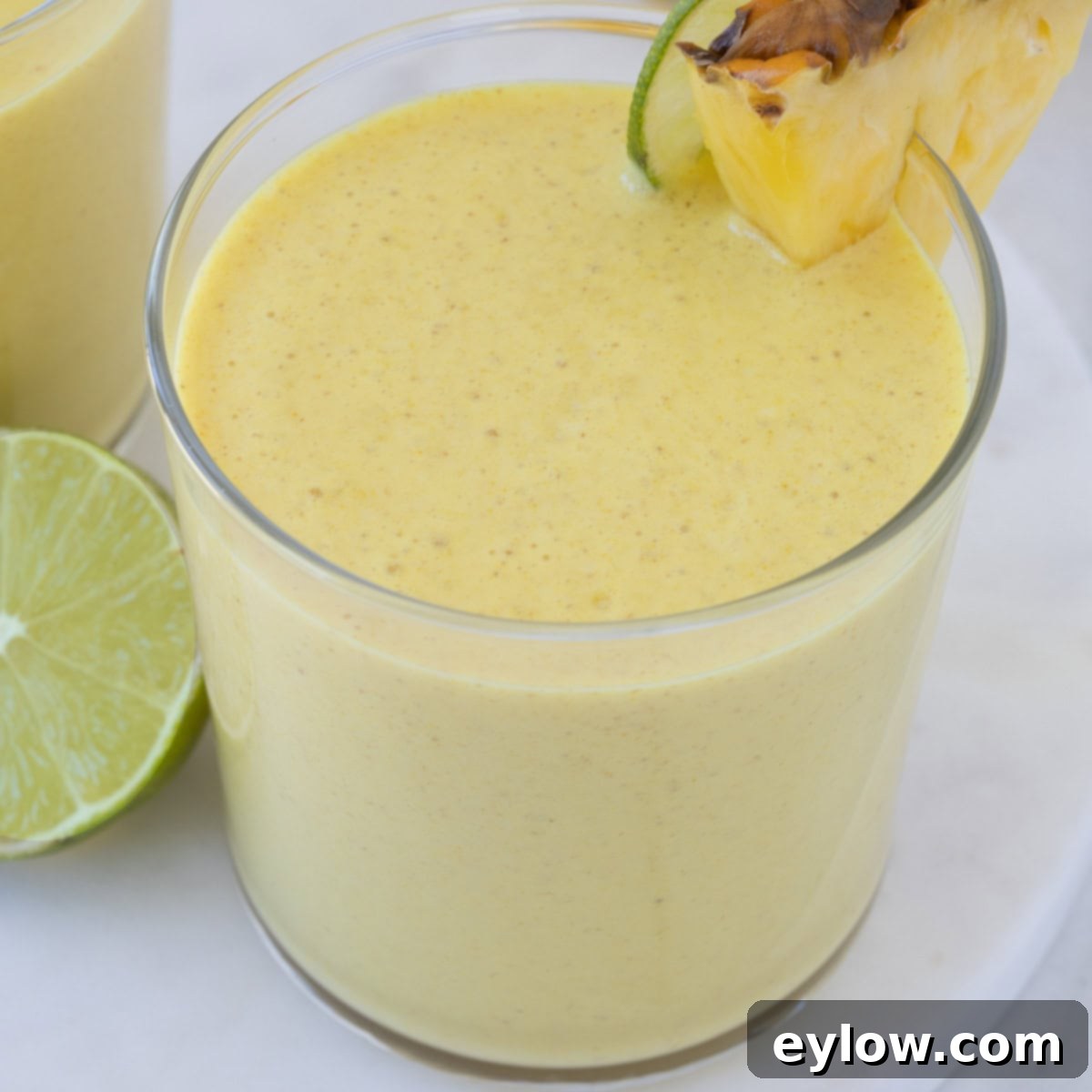Tropical Mango Pineapple Smoothie: Healthy, Protein-Packed & Refreshing Recipe
Craving a taste of the tropics that’s both invigorating and nutritious? Look no further than this delightful mango pineapple smoothie. It’s a perfect blend of sweet, tangy, and utterly refreshing, bursting with the vibrant flavors of ripe mango, juicy pineapple, and a zesty hint of lime. Forget the overly sweet, sugar-laden fast-food versions that offer little nutritional value. This homemade recipe allows you to enjoy a genuinely healthy alternative, prepared in just minutes with wholesome ingredients. Naturally sweetened by the fruits themselves, and boosted with protein from Greek yogurt and essential fiber, it’s an ideal way to kickstart your morning, refuel after a workout, or simply enjoy a delicious, guilt-free treat on a warm day.
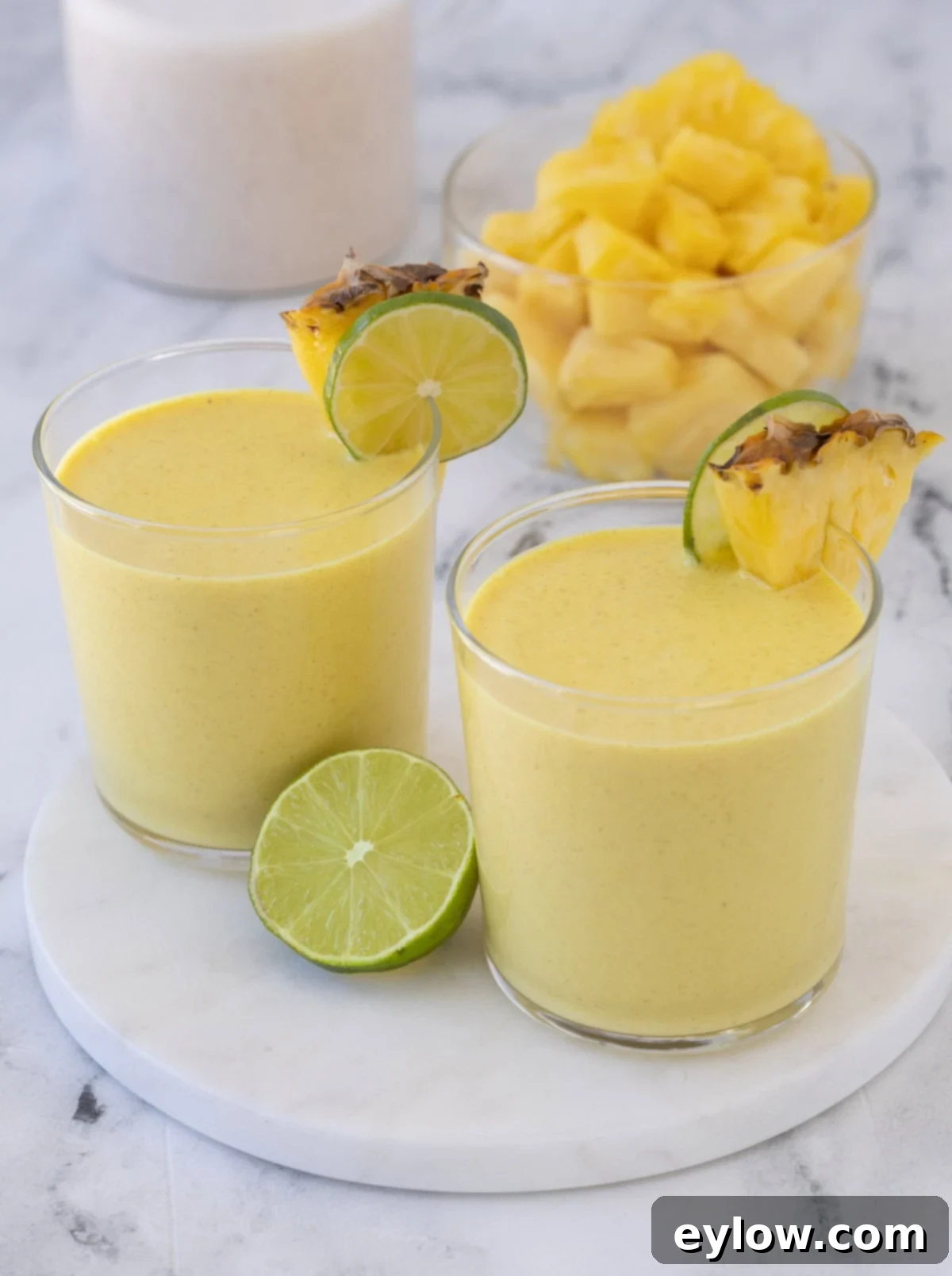
Many of us have fallen prey to the allure of a convenient smoothie from a fast-food chain, perhaps even a McDonald’s mango pineapple smoothie. However, a quick glance at the nutrition label of such options often reveals a shocking amount of added sugar, sometimes more than your daily recommended intake in a single serving. For instance, a medium mango pineapple smoothie from the golden arches can pack a staggering 57 grams of sugar (that’s about 14 teaspoons!) and offers a meager 3 grams of protein. This nutritional imbalance can lead to sugar crashes and does little to sustain your energy or contribute to a healthy diet. Our mission is to transform this perception of smoothies by showing you how simple it is to create a truly beneficial and equally delicious tropical smoothie right in your own kitchen, putting you in control of every wholesome ingredient.
[feast_advanced_jump_to]
Why You’ll Love This Healthy Mango Pineapple Smoothie Recipe
This isn’t just another smoothie recipe; it’s a game-changer for anyone looking for a healthy, convenient, and incredibly flavorful beverage. Here’s why this mango pineapple smoothie will quickly become a favorite:
- Effortless Preparation: This smoothie comes together in mere minutes, making it perfect for busy mornings or when you need a quick, nutritious boost. You can also prepare it ahead of time, allowing for a truly grab-and-go breakfast or snack that fits seamlessly into your schedule.
- Nutrient Powerhouse: Unlike many commercial smoothies, this recipe is intentionally designed to be high in protein and fiber. The Greek yogurt and optional protein powder provide a substantial protein boost, essential for muscle repair, satiety, and sustained energy. The whole fruits contribute significant fiber, aiding digestion and promoting a feeling of fullness.
- Flexible Fruit Options: Whether you prefer the vibrant sweetness of fresh fruit or the frosty convenience of frozen fruit, this recipe accommodates both. Using frozen mango and pineapple chunks creates an extra thick, frosty texture without the need for added ice, which can dilute the flavor.
- Significantly Less Sugar: The most compelling reason to choose this homemade version over a fast-food alternative is the drastic reduction in added sugar. By relying on the natural sweetness of ripe mango and pineapple, you avoid the excessive sugar spikes and empty calories found in many commercial offerings, ensuring a healthier and more balanced treat.
- Customizable to Your Taste: This recipe serves as a fantastic base that can be easily adapted to your dietary needs and flavor preferences, whether you want to amp up the protein, add greens, or explore different liquid bases.
If you’re already a fan of mango in your smoothies, you might also enjoy this bright and invigorating green smoothie with mango and spinach. It sounds unconventional, but the combination is truly delicious and produces a beautiful, vibrant color!
Essential & Optional Ingredients for Your Tropical Smoothie
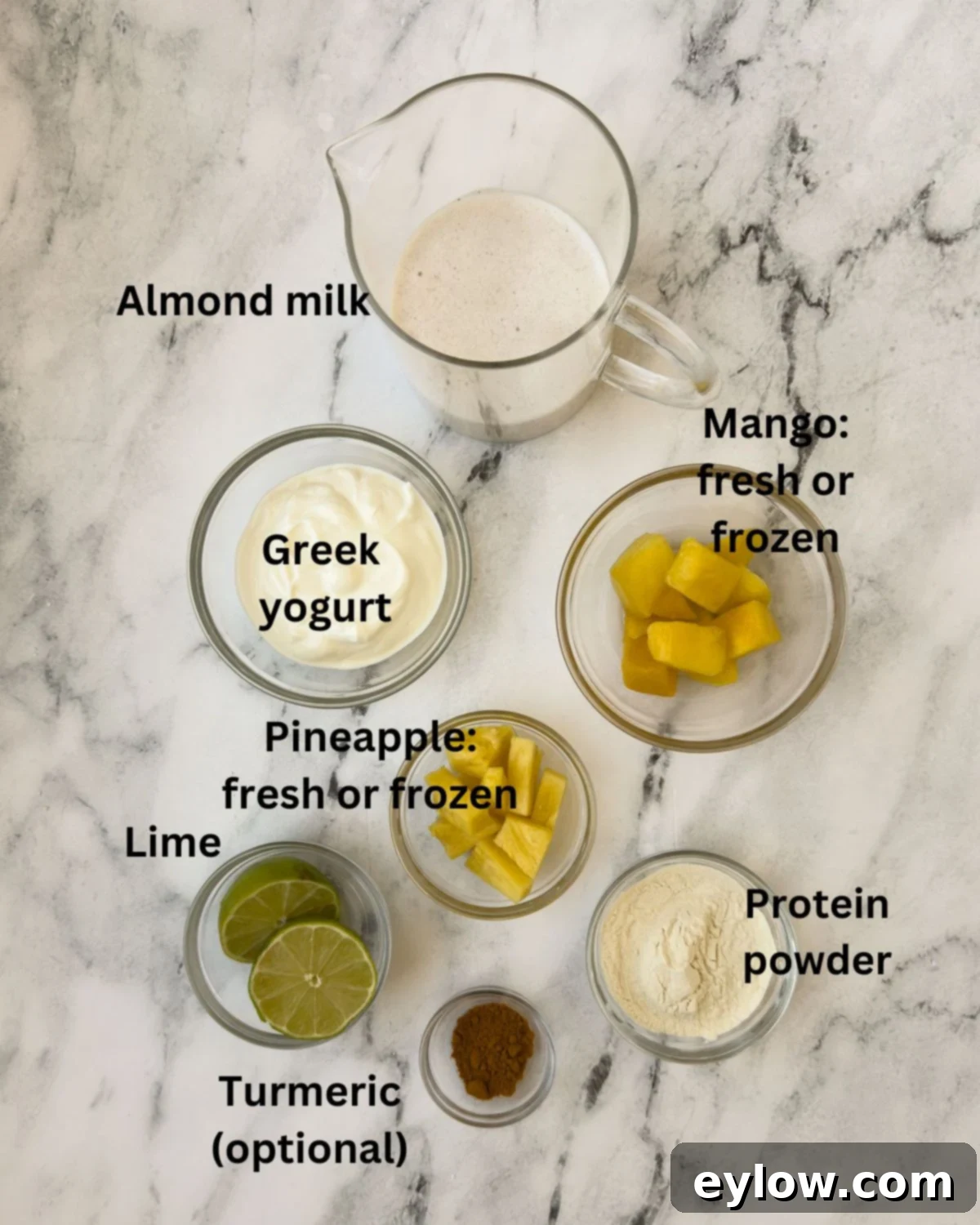
While this tropical smoothie is undeniably a delicious delight, it’s worth noting that mango and pineapple are naturally higher in sugar compared to some other fruits. Therefore, it’s wise to be mindful of the quantities you add. If you are following a low-carb diet or closely monitoring your sugar intake, consider this mango pineapple smoothie recipe more of an occasional treat rather than an everyday staple. Moderation and balance are key to enjoying its benefits.
- Milk: The liquid base for your smoothie. Coconut milk is an excellent choice for enhancing the tropical essence of this smoothie, lending a subtle creaminess and exotic flavor. However, other milk varieties work beautifully too, such as unsweetened almond milk (a neutral and popular option), homemade hemp seed milk (which adds extra protein and healthy fats), traditional dairy milk for added creaminess, or cashew milk for a rich, smooth texture.
- Yogurt: For the best protein boost and to control sugar content, always opt for unflavored plain Greek yogurt. Its thick consistency contributes to a luxurious creamy texture, while its high protein content helps keep you feeling full and satisfied. If you prefer a dairy-free option, unsweetened plain coconut or almond yogurt can be used.
- Protein Powder: An optional but highly recommended addition, especially if you’re aiming for a protein-rich breakfast or a post-workout recovery drink. Use your preferred brand and type – whey protein is a popular choice for its complete amino acid profile, while plant-based protein powders (like pea or brown rice protein) are great for vegans or those with dairy sensitivities. Vanilla-flavored protein powder can also add a complementary sweetness and aroma.
- Mango: The star of the show! You can use either fresh, ripe mango or frozen mango chunks. Frozen mango is particularly fantastic as it contributes to a frosty, thick smoothie texture without the need for excessive ice, which can dilute the flavor. If using fresh, ensure it’s ripe for maximum sweetness and aroma.
- Pineapple: A perfect complement to mango, adding a tangy sweetness and vibrant tropical flavor. Like mango, fresh pineapple or frozen pineapple chunks can be used. Frozen pineapple will help achieve a colder, thicker consistency.
- Lime: A crucial ingredient that elevates the entire flavor profile. A squeeze of fresh lime juice adds a bright, citrusy zing that cuts through the sweetness of the mango and pineapple, creating a beautifully balanced and refreshing taste. It also provides a welcome boost of Vitamin C.
- Turmeric: This is an optional addition, but highly recommended for both its vibrant golden color and its potent anti-inflammatory properties. Just a small amount will enhance the smoothie’s visual appeal and add a subtle earthy note without overpowering the fruit flavors.
- Vanilla: For an extra layer of tropical indulgence, a touch of vanilla extract or vanilla paste works wonders. Vanilla harmonizes beautifully with mango and pineapple, adding a warm, aromatic depth. If you’re using vanilla-flavored protein powder, you might find this addition unnecessary.
For more lower-sugar smoothie options, especially those featuring berries, be sure to check out my comprehensive smoothies recipe index page for a variety of healthy blends.
Chef’s tip: When crafting this particular mango pineapple smoothie, one tropical fruit I often choose to omit is banana. While bananas are frequently used in smoothie recipes for their natural sweetness and ability to create a creamy texture, this recipe typically doesn’t require additional sugar or a thicker consistency, as the mango, pineapple, and Greek yogurt already provide ample creaminess and sweetness. Can you add banana if you really want to? Yes, absolutely – both fresh or frozen banana will work. However, in my opinion, it’s not strictly necessary for this specific tropical flavor profile, but the choice is ultimately yours!
Exciting Substitutions and Creative Variations
This mango pineapple smoothie recipe is wonderfully versatile, allowing you to experiment and tailor it to your preferences or what you have on hand. Don’t be afraid to get creative!
- Adventurous Spice: It might sound unconventional, but a tiny pinch of mild curry powder can add a surprisingly delightful warmth and complexity to this tropical blend. Its earthy notes beautifully complement the sweet fruits. Start with a very small amount and adjust to taste.
- Citrus Swap: If lime isn’t available, or you prefer a slightly different tang, feel free to swap lemon juice for lime juice. Lemon offers a brighter, sharper acidity that can also temper the sweetness effectively.
- Protein Customization: To meet your specific protein requirements, you can adjust the balance between protein powder and Greek yogurt. Use either all protein powder, more yogurt, or a combination of both. You can also add other protein sources like silken tofu or a spoonful of nut butter.
- Fiber Boost: For an extra dose of fiber and beneficial omega-3 fatty acids, incorporate a tablespoon of ground flax seed or chia seeds. These will also help thicken the smoothie slightly.
- Adjust Sweetness: While the fruits provide natural sweetness, if you desire an even sweeter smoothie, consider adding a small amount of natural sweeteners like maple syrup, honey, or a sugar-free alternative such as monk fruit or stevia. Remember, these fruits are already quite sweet, so taste as you go!
- Tropical Liquid Base: For an even more intense tropical experience, try using coconut water as your liquid base instead of milk. It’s incredibly hydrating and pairs perfectly with the fruit flavors. Just be sure to read the labels carefully to avoid varieties with added sugars.
- Enhanced Vanilla Notes: Beyond vanilla extract, you could use ground vanilla bean powder or even a vanilla bean paste for a more intense and authentic vanilla flavor. Alternatively, if you’re using a vanilla-flavored protein powder, additional vanilla might not be needed.
- Add Some Greens: For a hidden boost of nutrients, toss in a handful of spinach or kale. The strong flavors of mango and pineapple will mask the taste of the greens, leaving you with all the benefits without the “green” flavor.
- Ginger Zing: A small piece of fresh ginger root (peeled and grated) can add a wonderfully spicy and warming kick that complements the tropical fruits.
On a savory note, did you know that fresh pineapple mango salsa is absolutely terrific with grilled chicken, fish, shrimp, and many other dishes? It’s brightly flavored and a delicious addition to any meal if you’ve never made it before.
Chef’s tip: What NOT to use in a pineapple mango smoothie? To maintain the health benefits and control sugar levels, it’s crucial to steer clear of highly processed fruit products. This includes any mango puree concentrate, pineapple puree, pineapple juice, fruit juice concentrate, or orange juice concentrate. Why? These products are essentially pure sugar, stripped of their beneficial fiber content. Consuming them will lead to a rapid spike in your blood sugar. Instead, always prioritize using whole fruit that still contains its natural fiber. This approach ensures you get the full nutritional benefits and experience a more sustained release of energy.
Another excellent and surprisingly refreshing combination with pineapple is frozen cucumber. It sounds a bit unusual, but the crisp, cool flavor of cucumber provides a fantastic contrast to the sweetness of the fruit. Learn how to cut up and freeze cucumber for smoothies by checking out my cucumber smoothie post.
Effortless Blending: Your Guide to a Perfect Smoothie
Making this mango pineapple smoothie is incredibly simple, requiring minimal effort for maximum flavor. Here’s a detailed look at the process:
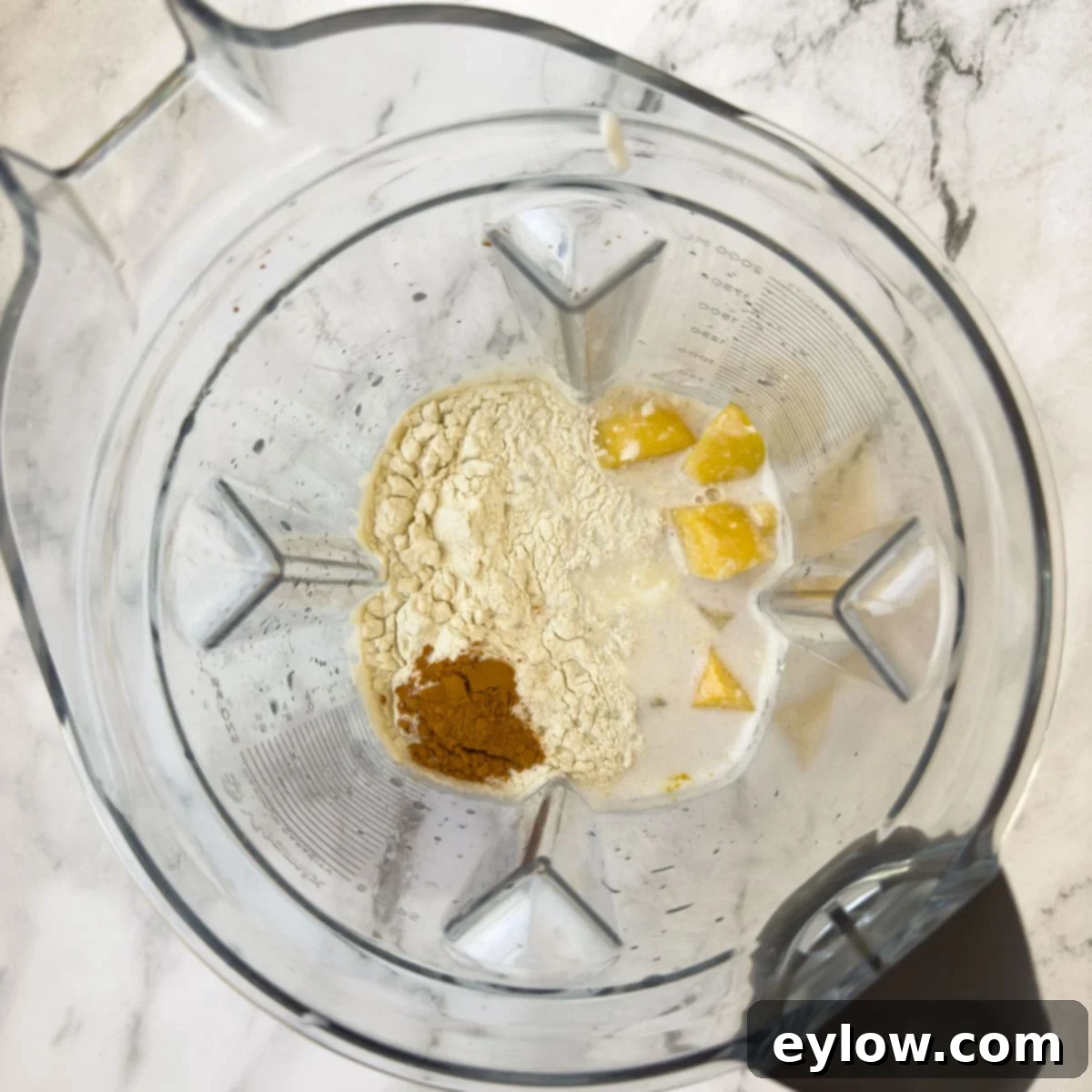
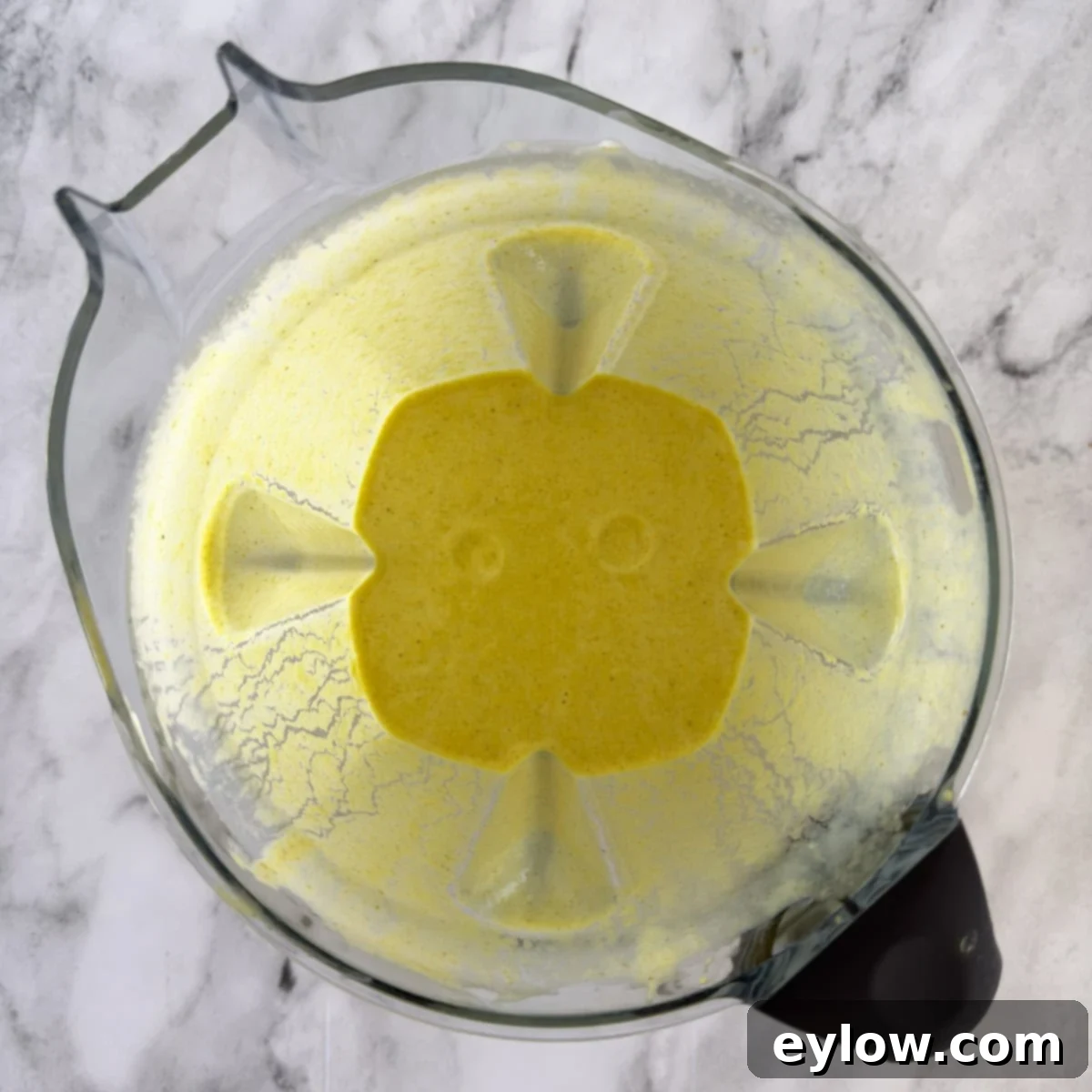
While any blender can get the job done, a high-speed blender will undoubtedly offer the smoothest, creamiest texture and work significantly faster. If you’re using a standard or personal blender, you might need to blend for a bit longer or add a touch more liquid to achieve your desired consistency.
To begin, always add your liquid ingredients to the blender container first. This crucial step helps the blades spin freely and prevents them from getting stuck, especially when dealing with frozen fruit. So, pour in your milk of choice first, followed by the Greek yogurt. Next, add your chopped mango (fresh or frozen), pineapple (fresh or frozen), protein powder (if using), fresh lime juice, and finally, the turmeric (if you’re incorporating it for color and health benefits). Secure the lid tightly and begin blending on a low setting to initially break down the frozen fruit and other ingredients. Once the mixture starts to combine, gradually increase the speed to high and continue blending until the smoothie is completely smooth and creamy, with no visible chunks of fruit. If it’s too thick, add a splash more milk; if too thin, a few extra frozen fruit pieces or ice cubes will do the trick.
Enjoying Your Tropical Creation: Serving & Storage Tips

For the freshest and most vibrant flavor, it’s always best to serve your mango pineapple smoothie immediately after blending. The cold, creamy texture and bright flavors are at their peak right out of the blender. However, life happens, and sometimes you need to prepare ahead.
If you’re not planning to drink it right away, you can store your smoothie in an airtight container or jar in the refrigerator for up to 24 hours. To prevent oxidation and maintain freshness, fill the container as close to the brim as possible. If you’re taking it on the go, an insulated thermos is an excellent choice to keep it chilled for several hours. When ready to enjoy, simply give it a good shake or stir to re-blend any separation that may have occurred. This makes it a fantastic option for a quick breakfast during a hectic week or a convenient post-workout refuel.
Garnish your smoothie with a wedge of fresh lime, a slice of pineapple, or even a sprinkle of toasted coconut flakes for an extra touch of tropical flair. This smoothie is a complete meal in itself for breakfast or a hearty snack, but it also pairs well with a light breakfast like oatmeal or whole-grain toast. For another beloved classic, don’t miss this creamy strawberry banana smoothie with yogurt.
Common Questions About Mango Pineapple Smoothies
While this smoothie is truly best enjoyed fresh for optimal flavor and texture, you can certainly prepare it in advance. Store it in an airtight container in the refrigerator for up to 24 hours. To minimize separation and maintain freshness, fill the container as full as possible, leaving minimal air. Before drinking, simply give it a vigorous shake, stir well, or even a quick re-blend to restore its smooth consistency.
Increasing the protein content of your smoothie is easy and highly beneficial for satiety and muscle health. The primary method is to add protein powder – choose your preferred type, whether it’s whey, casein, or a plant-based option like pea or rice protein. Another excellent source is plain Greek yogurt, which is naturally high in protein. For a vegan option, consider adding silken tofu, which blends seamlessly and provides a creamy texture along with protein. You can also incorporate a handful of nuts or seeds, such as hemp seeds (a complete protein source) or chia seeds (rich in protein and fiber). A combination of these options will help you round out your protein needs effectively. Additionally, compare the protein levels of different milks; homemade hemp seed milk, for example, offers a higher protein count than many other non-dairy alternatives.
Generally, no, added sweeteners are not necessary for a tropical fruit smoothie, especially when using ripe mango and pineapple. These fruits are naturally high in sugar and provide ample sweetness on their own. The lime juice also helps to balance their sweetness. If, after tasting, you find you truly need it sweeter, consider using a natural, alternative sweetener without added sugars, such as a small amount of monk fruit extract, stevia, or a touch of pure maple syrup or honey, always in moderation.
While a high-powered blender (like a Vitamix or Blendtec) will undoubtedly create the smoothest, most velvety texture and process ingredients faster, it is by no means essential. You can absolutely make a delicious smoothie with almost any standard kitchen blender or even a personal-sized blender. If using a less powerful blender, you might need to blend for a longer duration, occasionally pause to scrape down the sides of the pitcher, or add a little more liquid to help the blades move. Patience is key, and you’ll still achieve a wonderfully blended smoothie!
Absolutely! Adding a handful of spinach or kale is an excellent way to boost the nutritional profile of your smoothie without significantly altering its delicious tropical flavor. The strong, sweet tastes of mango and pineapple are very effective at masking the earthy notes of most leafy greens, making it a perfect “hidden veggie” smoothie. Start with a small amount and gradually increase to your preference.
To achieve a thicker smoothie, add more frozen fruit (mango or pineapple work best), a few ice cubes, a tablespoon of chia seeds or ground flax seeds (which absorb liquid), or a bit more Greek yogurt. For a thinner consistency, simply add more of your chosen liquid base, whether it’s milk or coconut water, a little at a time until you reach your desired pourable texture.
More Delicious & Healthy Fruity Smoothies to Explore
If you’ve enjoyed the tropical goodness of this mango pineapple smoothie, you’re in for a treat with these other healthy and fruity smoothie recipes. Each offers a unique blend of flavors and nutrients, perfect for any time of day:
- 5-Minute Cherry Smoothie Recipe
- Green Detox Smoothie Recipe
- Raspberry Smoothie
- Chocolate Blueberry Smoothie (high protein)
⭐️Did You Make This? Share Your Experience!
If you take the time to blend up this invigorating mango pineapple smoothie, I would absolutely love to hear your thoughts! Please feel free to leave a comment below and let me know how you enjoyed it. Your feedback means a lot to me and helps other readers. If you truly loved it and think it deserves recognition, please consider giving it a 5-star rating! Your ratings are incredibly helpful and much appreciated.
📖 Recipe
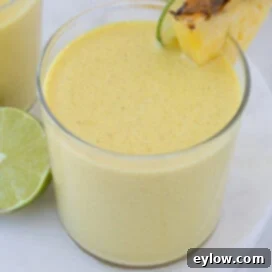
Mango Pineapple Smoothie
Sally Cameron
Pin Recipe
Equipment
-
High speed blender
Ingredients
- 10 ounces unsweetened almond milk or milk of choice (coconut, hemp, or dairy milk also work)
- ½ cup plain Greek yogurt
- ½ cup chopped mango fresh or frozen chunks
- ¼ cup pineapple fresh or frozen chunks
- ½ scoop protein powder plain or vanilla (optional, for extra protein)
- ½ teaspoon turmeric powder (optional, for color and health benefits)
- 1 lime juiced (about 1-2 tablespoons)
- ½ teaspoon vanilla extract or vanilla paste (optional, if not using vanilla protein powder)
Instructions
-
To your blender container, add the liquid ingredients first (milk), followed by the Greek yogurt. Then, add all remaining ingredients: chopped mango, pineapple, protein powder (if using), lime juice, turmeric (if using), and vanilla extract (if using). Secure the lid and blend on a low speed initially to break down the fruit, then gradually increase to high speed until the smoothie is completely smooth and creamy. If you desire an even frostier or thicker smoothie, you can add a few extra ice cubes before blending. Serve immediately and enjoy!
Notes
For more healthy smoothie tips: If you’re looking to dive deeper into making nutritious and delicious blends, please refer to my comprehensive Healthy Smoothie Guide for detailed advice and creative ideas.
Nutritional information: The nutritional information provided here is an estimate calculated as a courtesy. It may vary based on the specific brands and quantities of ingredients you use. For precise nutritional data, we recommend calculating the actual information with your preferred nutritional calculator using the exact products you are consuming.
